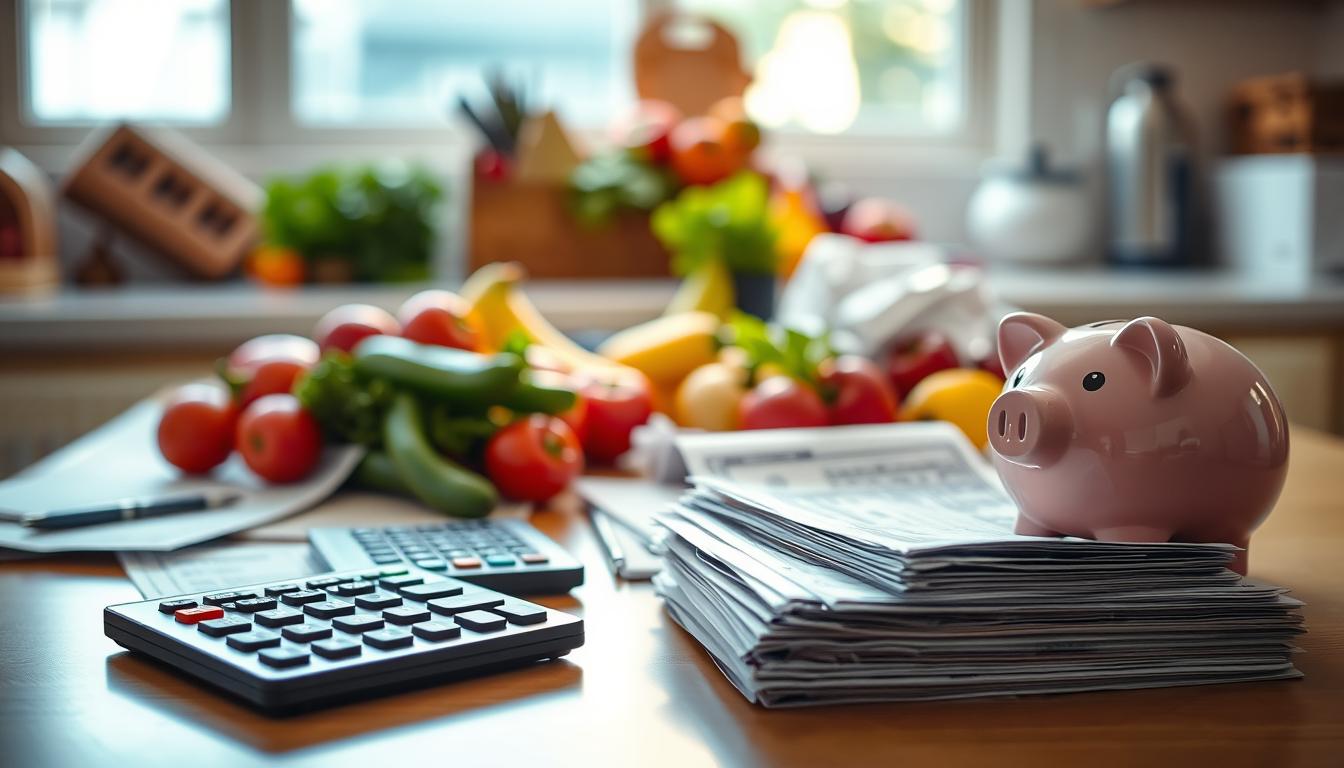The 3-3-3 Grocery Rule: Are you tired of spending too much on grocery shopping? There’s a simple way to cut down on your weekly costs.
The 3-3-3 Grocery Rule is easy and effective. It helps you save money without sacrificing the quality of your meals.
This article will show you how to make a shopping list using the 3-3-3 rule. It’s tailored to fit your lifestyle, so you can start saving money right away.
Contents
- 1 What Is the 3-3-3 Grocery Rule?
- 2 The 3-3-3 Grocery Rule: A Practical Approach to Saving Money
- 3 Creating Your 3-3-3 Shopping List
- 4 Meal Planning with the 3-3-3 Method
- 5 Adapting the 3-3-3 Rule to Your Lifestyle
- 6 Conclusion: The 3-3-3 Grocery Rule
- 7 FAQ
- 7.1 What is the 3-3-3 Grocery Rule?
- 7.2 How do I allocate my budget using the 3-3-3 Grocery Rule?
- 7.3 What are staples, essentials, and treats in the context of the 3-3-3 Grocery Rule?
- 7.4 How can the 3-3-3 Grocery Rule help in saving money?
- 7.5 Can the 3-3-3 Grocery Rule be adapted to different lifestyles and dietary needs?
What Is the 3-3-3 Grocery Rule?
Looking for grocery shopping tips? The 3-3-3 Grocery Rule is a good starting point. It’s a simple way to organize your shopping into three groups: staples, essentials, and treats.
This rule helps you budget better. It keeps you from spending too much on one thing. You get the basics and still have room for fun items.
The 3-3-3 Grocery Rule is all about saving money. Here’s how to use it:
- Find your staples: These are things like rice, pasta, and canned goods you always use.
- Make a list of essentials: This includes fresh fruits, meats, and dairy for your meals.
- Pick your treats: These are items you like but don’t need, like desserts or special foods.
Using this rule helps you shop smarter. It makes grocery shopping more affordable and enjoyable.
The 3-3-3 Grocery Rule: A Practical Approach to Saving Money
The 3-3-3 grocery rule helps you save money without sacrificing quality. It divides your groceries into three main groups. This way, you can manage your spending better.
Benefits of the 3-3-3 Grocery Rule
Using the 3-3-3 grocery rule can greatly benefit your budget and shopping. Some key benefits include:
- Reduced Impulse Buys: Sticking to your list helps you avoid impulse buys that can ruin your budget.
- Better Budgeting: It helps you spread your grocery budget evenly. This ensures you have enough for the essentials.
- Less Food Waste: Planning your shopping and buying only what you need reduces waste and saves money.
Here’s a table showing how you can allocate your budget with the 3-3-3 rule:
| Category | Budget Allocation | Example Items |
|---|---|---|
| Essentials | 50% | Milk, Bread, Eggs |
| Proteins | 30% | Chicken, Beef, Fish |
| Pantry & Snacks | 20% | Canned Goods, Snacks, Spices |
By using this rule, you can shop for groceries in a more balanced and controlled way.
Also, the 3-3-3 rule makes meal planning and shopping more organized. This can lead to more savings and less stress when managing your budget.
Creating Your 3-3-3 Shopping List
Making a 3-3-3 shopping list means sorting your grocery needs into three groups. You’ll have staples, essentials, and treats. This way, you can plan your meals better and manage your grocery list well.
First, list your staples. These are the main items in your pantry like rice, pasta, canned goods, and spices. They’re non-perishable and are the base of many meals.
Then, add your essentials. These include fresh fruits and veggies, dairy, meats, and bread. They’re key for your daily meals and change based on what you like to eat.
Lastly, think about your treats. These are special items, indulgences, or things you enjoy but don’t need every day. Treats can make your meals more exciting and make shopping fun.
Here are some tips for making a good 3-3-3 shopping list:
- Plan your meals for the week to figure out your essentials.
- Check your pantry to see what staples you need to buy.
- Remember the treats you want to get.
- Organize your list to match your grocery store’s layout to save time.
By following these steps and tips, you can make a detailed 3-3-3 shopping list. It helps with meal planning and keeps your budget in check. Making a good list is crucial for saving money and successful grocery shopping.
Meal Planning with the 3-3-3 Method
Meal planning is a key part of the 3-3-3 Grocery Rule. It helps save money and reduce waste. By planning meals around staples, essentials, and treats, you get a balanced diet.
Start by planning meals with staples like grains, canned goods, and non-perishables. Then, add essentials like fresh produce, dairy, and proteins. Finally, include treats for variety and fun.

| Meal | Staples | Essentials | Treats |
|---|---|---|---|
| Breakfast | Oatmeal | Fresh fruits | Nuts |
| Lunch | Canned beans | Grilled chicken | Avocado |
| Dinner | Pasta | Marinara sauce, vegetables | Garlic bread |
This meal planning method saves money and reduces waste. It makes grocery shopping more efficient. With a clear plan, you avoid buying unnecessary items and use all ingredients.
Effective meal planning is all about balance and flexibility. Adjust your plans based on sales and what’s in season. This flexibility is key to the 3-3-3 Grocery Rule.
Adapting the 3-3-3 Rule to Your Lifestyle
The 3-3-3 Grocery Rule is not for everyone. It’s a flexible guide that you can adjust to fit your life. Whether you’re busy, have a big family, or special dietary needs, it can be tailored for you.
If you’re on a tight budget, you might spend more on basics and less on treats. Or, if you want to splurge, you can adjust your budget. The important thing is to watch your spending and tweak the rule as needed.
Adapting grocery shopping habits is key to making the 3-3-3 Rule work. This could mean planning meals, shopping when things are on sale, or using coupons. Being flexible and responsive to your needs helps you get the most out of this frugal living tip.
Here are some tips to help you adapt the 3-3-3 Rule to your lifestyle:
- Think about your dietary needs and likes to find the right mix of staples, essentials, and treats.
- Change your budget based on your financial situation and shopping goals.
- Plan your meals and shopping to save money and reduce waste.
By following these tips and keeping an eye on your spending, you can make the 3-3-3 Rule work for you. This way, you can live frugally while still enjoying your grocery shopping.
Conclusion: The 3-3-3 Grocery Rule
You now know how the 3-3-3 Grocery Rule can save you money. It’s not just about cutting costs. It’s about shopping smarter and more mindfully.
Creating a 3-3-3 shopping list is key. It helps you shop better and save money. This can really help your budget.
Try the 3-3-3 Grocery Rule today and see your savings grow. It’s easy and flexible. Making a few changes can save you money and make shopping easier.
See Also: How to Drastically Cut Your Grocery Bill: Simple Hacks
FAQ
What is the 3-3-3 Grocery Rule?
The3-3-3 Grocery Rule is a simple way to shop for groceries. It divides items into three groups: staples, essentials, and treats.
How do I allocate my budget using the 3-3-3 Grocery Rule?
Divide your budget into three parts: staples, essentials, and treats. This helps you not spend too much on any one thing.
What are staples, essentials, and treats in the context of the 3-3-3 Grocery Rule?
Staples are things like rice, pasta, and canned goods. Essentials include fresh fruits and veggies, dairy, and meats for daily meals. Treats are special items or indulgences.
How can the 3-3-3 Grocery Rule help in saving money?
It helps by organizing your shopping. You can avoid buying things on impulse, stick to your list, and waste less food.
Can the 3-3-3 Grocery Rule be adapted to different lifestyles and dietary needs?
Yes, it’s flexible. You can adjust it based on your budget, lifestyle, and dietary needs. It works for many households and individuals.

Hi, I’m Vanda Costa — a mom, wife, homemaker, and the voice behind TipsToFeelBetter. I’m passionate about creating a peaceful, organized home where my family can thrive.
I love everything that brings simplicity and comfort to everyday life — from organizing closets and preparing healthy meals to decorating with intention and making family routines run smoother.
As a proud mother of an 8-year-old daughter, I know the beauty (and chaos!) of balancing household tasks, school runs, meal planning, and quality time — all while staying grounded and intentional.
Through this blog, I share real-life tips that I’ve tested and embraced, hoping to inspire other women who want to feel more in control of their homes and lives — without the pressure of perfection.
Thanks for being here — I’m so glad we’re on this journey together!

